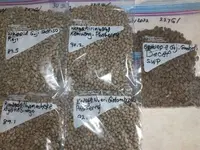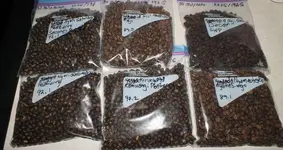Billy Banana, great question. I always run a cool down cycle between beans. I do this for two reasons.
1. It extends the life of the heating coil on the Gene Cafe.
2. It returns my starting temperature to a point which helps make the roasts more "repeatable in outcomes".
I have always insisted giving the 20 dollar plus beans, a longer cooling rest on the Gene Cafe before beginning them. Many of them are lower altitude beans. Repeatability is important to me.
Based upon my measurements, the cooling cycle automatically stops when the exhaust air temperature drops below 150 degrees F (65.5 C). If all your roasts begin with a 5 minute pre-heat, this gets you at a fairly consistent point. For the pricier beans, I give it the time to get a bit closer to ambient temperature, to try to further constrain the outcomes. I use that time to catch up on my roasting notes, and do calculations for moisture loss and development.
A couple roasts sessions ago, I was doing some Jamaica Blue Mountain, Kona Peaberry, Panama Finca Lerida Geisha, and the inexpensive Bali Kintamani beans. All of them got a longer than normal pause between roasts (after the cooling cycle). The pause for most of them was an extra ten minutes. The reason why the Bali beans got some "extra love" was because the first two attempts with that bean were disappointing.
A little information on what is collected in my roasting notes:
Beginning weight of roast, for me it is 8 ounces (227 grams).
Ending weight of roast is recorded, and used to calculate moisture loss.
Moisture loss calculation.
Time which the beans turned Full Yellow.
Time which the first crack was heard from the beans. This is used as part of the calculation of development time.
Times which temperature changes were made on the roaster (up or down, and the degrees at those steps).
Time the roast was completed, and the beans were dumped into the bean cooling device. (second factor used to calculate development time).
And Calculated Development time.
Notes may include those values recorded from previous notes, to see how consistent my roasting is. It may contain how a value is selected to be changed, to improve the outcome.
It also includes a once a minute note log on the progression which the bean is roasting. It includes factors like smells, color, non-color changes in the bean (puffing, swelling, seam spreading, chaff releasing, cracks forming etc). Also notes of when smoke is seen leaving the chaff collector.
Finally, I also take two temperature measurements each minute. Once is via a thermocouple located in the chaff collector, and the second is via optical pyrometer which is measuring external drum temperature at a specific spot on the drum as it rotates around.
The goal of all this note taking is to improve my understanding of the roast process, and the small details which can affect the outcome. It also keeps me very busy during the roast. Occasionally, if I am roasting a bean which I am very familiar with, which gives repeatable outcomes, I will dispense with all the note taking, and simply read my notes from a previous roast of the bean, and repeat the recorded steps. I may note where I want to tweak it a bit, and make minor changes to reduce moisture loss, or decrease development time (if it was previously excessive).
Sometimes I incorporate cupping notes at the end of the roasting notes. This can help me figure out how to tweak the roast to modify the outcome. i.e. if the bean is supposed to be floral and fruity, but ends up with those characteristics diminished in the cup... it helps me realize my roasting curve needs adjustment.

